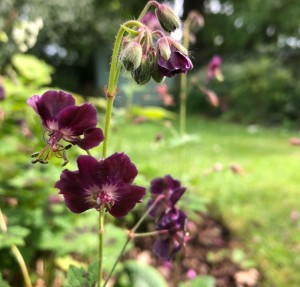Novice gardeners—and even some experienced ones—often curse the shade that looms over their beds, borders and other growing spaces. One of the immutable facts of gardening life is that if you want armloads of roses or bushels of tomatoes, you need lots of sunshine.
Given that reality, you have two choices. Either you can move to a place with optimal sunshine, or you can come to terms with shade. With the time and expense involved in moving, it’s probably better to come to terms with shade and use it as an opportunity to broaden your horticultural horizons. You can create all kinds of beauty in less-than-sunny conditions with the right plants. It is even possible to work this miracle under trees. You don’t have to sacrifice flowers either, though those flowers are usually not as big and flashy as peonies or gladioli.
I have plenty of shade and I fill the spaces with all kinds of plants. I especially like a shade-loving hardy geranium that is known botanically as Geranium phaeum, and known less optimistically as “the mourning widow”, or “dusky geranium”.
“Mourning widow” sounds like something out of Victorian funerary art, but it is simply descriptive of the species’ dark maroon to near-black flowers. Each one has five petals, just like the individual flowers of a windowbox geranium or pelargonium. As with other hardy geraniums, the blossoms appear singly, rather than in cluster form.
I first got acquainted with Geranium phaeum when I saw it growing in the garden of a friend who is a professional gardener. His garden is like a miniature botanical institution, with all kinds of interesting species, but I was very taken with his healthy clumps of ‘Samobor’. Like most phaeums, the plants stand up to 24 inches tall and perhaps 12 inches wide. The nodding flowers at the tops of the stalks are dark, with slightly reflexed petals and a white “eye” in the center of each bloom. ‘Samobor’s late spring flowers are lovely, but its best features are the leaves, which bear distinctive, pointed lobes. To add to the show, each leaf is also marked with a wide ring of dramatic purple-black blotches.
‘Samobor’, a naturally occurring variant of the phaeum species, was discovered over two decades ago growing at an English nursery. Fittingly for a member of a species native to Croatia and other locations in Eurasia, it was named after a Croatian town. In this country, the variety was introduced into commerce by the late lamented Heronswood Nursery of Kitsap, Washington. Though not as wildly popular as sun-loving hardy geraniums like ‘Rozanne’, ‘Samobor’ has acquired a following of its own.
But ‘Samobor’ is only the beginning. A check of the online specialty plant marketplace reveals a host of mourning widow varieties with flowers in many shades of mourning dress. Some feature leaf blotches, like those of ‘Samobor’, while others bear lighter or darker lobed green leaves.
Langthorn’s’ Blue’ is enchanting, with maroon leaf splotches and reflexed blue-purple flowers suffused with white. ‘Album’—definitely not in mourning–looks positively cheerful, with pure white flowers and somewhat marked foliage. ‘Alec’s Pink’, another English variety, sports blooms of reddish purple, with contrasting veins and deeply dissected foliage. German breeders have brought forth the strong-sounding ‘Walkure’, which charms the eye with the white overtones on its purplish blooms. ‘Lavender Pinwheel’ looks just the way it sounds, with crinkled pinwheel petals and maroon-blotched foliage. ‘Merry Widow’ is among the most beautiful of the phaeum varieties, with lavender petals that darken to form a purple ring at the center of each flower.
If Geranium phaeum works in your shade garden and you have the space, try growing clumps of several varieties to make the most of the contrast in foliage textures and colors.
Encourage mourning widows to thrive by providing them with partial—or even less than partial–shade and consistently moist soil. Moisture is most important when they are establishing themselves. Thereafter, the plants can tolerate some drought, not to mention slugs and deer. No matter what the conditions, I am inclined to help Mother Nature with a good blanket of mulch. Like all cranesbills, the phaeum varieties develop seedheads that resemble long-beaked birds. Those birds will eventually spit seeds some distance, so be on the lookout for baby mourning widows—sometimes in unexpected places.
Mourning widow is an overly grim nickname for a very useful group of perennial plants. The flowers last for a time, but the foliage carries the plants handily and gracefully through the entire growing season. Find a good selection at Digging Dog Nursery, 31101 Middle Ridge Rd., Albion, CA 95410, (707) 937-1130, www.diggingdog.com. Another excellent source is Geraniaceae, 122 Hillcrest Ave., Kentfield, CA 94904, (415) 461-4168, geraniaceae.com.

